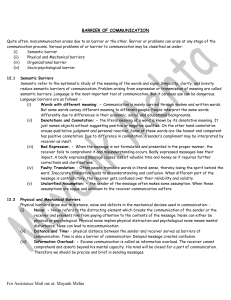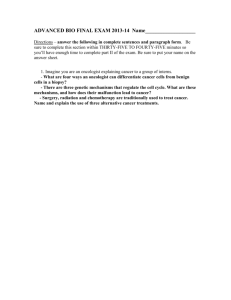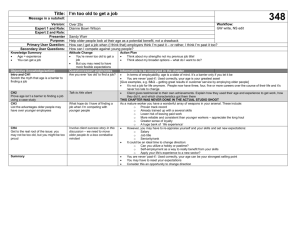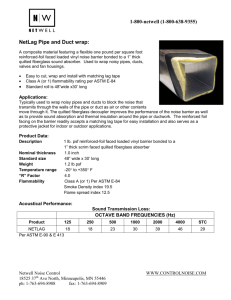Barriers of Communication
advertisement
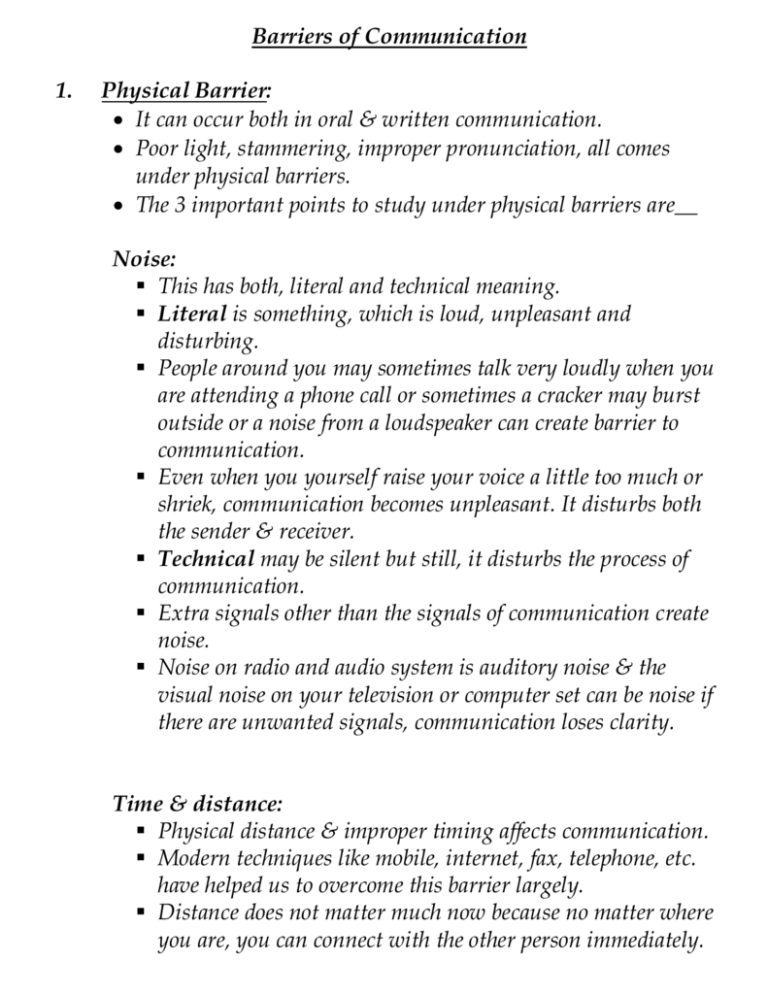
Barriers of Communication 1. Physical Barrier: It can occur both in oral & written communication. Poor light, stammering, improper pronunciation, all comes under physical barriers. The 3 important points to study under physical barriers are__ Noise: This has both, literal and technical meaning. Literal is something, which is loud, unpleasant and disturbing. People around you may sometimes talk very loudly when you are attending a phone call or sometimes a cracker may burst outside or a noise from a loudspeaker can create barrier to communication. Even when you yourself raise your voice a little too much or shriek, communication becomes unpleasant. It disturbs both the sender & receiver. Technical may be silent but still, it disturbs the process of communication. Extra signals other than the signals of communication create noise. Noise on radio and audio system is auditory noise & the visual noise on your television or computer set can be noise if there are unwanted signals, communication loses clarity. Time & distance: Physical distance & improper timing affects communication. Modern techniques like mobile, internet, fax, telephone, etc. have helped us to overcome this barrier largely. Distance does not matter much now because no matter where you are, you can connect with the other person immediately. Conference calls have also helped in-group interaction, which saves both time and money. But these techniques have their own drawbacks; The lines get jammed when too many people start using the system at a same time. A virus can enter the computer & snap your connectivity. In older days, communication to distant places was done through sound & visual signals like flames or drumbeats to save time and send the message immediately. 2. Symantic Barrier: This means different meanings of one word or phrase in all languages. Thus, a person should not just be aware of all meanings but we should also know to use the right word at the right time. The word used must be understood & make sense to the receiver. This can be further divided in 3 parts… Interpretation of Words: In some of the languages, including English, one word will have multiple meanings & the meaning, which you like to communicate, may not be received by the receiver. This creates a major barrier in the communication. E.g. Mum - food/mother/quiet It is necessary to use words & phrases that are common in the area or country you live in. E.g. In India-Gas means -Cooking gas while in America-Gas means –Petrol/Gasoline. Technical Jargon: It refers to words or expression used in particular profession, which has a précis meaning & is difficult to understand outside the context. E.g. “Software”-Computer terminology that may not mean anything else outside its context. Idioms & Phrases: Group of words that has a special meaning different from the meaning of the individual words used decoratively are called idioms. E.g., Cock & Bull Story- means to make up a story. Phrases are group of words, which form a natural part of a sentence but give a new meaning and not a literary meaning. These two are not barriers, rather they make communication more effective provided they are used under the following three conditions_ _Idioms should not be an old one. _It should fit the context _ it should be understood by the receiver. 3. Psycho-Sociological Barrier: Each individual is different from the other in terms of thoughts, feelings, temperament, senses, educational and social background, etc. Therefore, this difference ought to show in one to one or group communication. Status Block: There is a hierarchy in any organization and people in horizontal line find it easier to communicate with each other because they have similar education and social background and they may hold some rank or position in any organization. However, on vertical line, there is difference in ranks, education and social standing, because of which when they communicate difference shows. The difference is in language, fluency and confidence. In spite of the fact, the superior tries to be positive & amicable with his junior. This communication cannot be as natural as between two members of the same level. This status block makes communication difficult. Closed-mind: If a person, holding a superior position in a Company has an air of superiority, he may not open to outside influences and views. Such people are highly opinionated and egoistic. They are very difficult to deal with. If you try to persuade in communicating with them, they may lose their temper. Communication becomes impossible under such circumstances. Emotions: Being at the same level, physically, mentally and emotionally, is an important condition for effective communication. When you are in anger, you cannot communicate well. Similarly, when you are in grief or you are going through any extreme emotional condition, communication becomes difficult. You are not at your rational best. You do not get to say right words at the right time, so it shows that you can communicate better only when you are your natural self. A prejudiced mind is also as enemy of good communication, because if you are prejudiced, you form opinions about a person even before he/she speaks to you. A cool well-balanced personality with good communicative skills makes one an ideal communicator. Group Identification: Man is a social animal and his thinking is shaped by the attitudes and beliefs of his/her family, school community and friends. This thinking prompts us to have selective interaction and prejudiced responses. E.g., we may not like to speak to people belonging to a particular community, region, class, gender, etc. because of the prejudice we have against them. This becomes a barrier in communication. It is important for people at both the ends to be aware of this so that they can overcome this barrier. Within an organization, steps should be taken to minimize the chances of group identification created by a mental block that is based on religion, region, gender, social class, etc. Better official communication takes place only when individuals share common office culture. 4. Poor Communication Skills: Speaking, Listening, Reading and Writing are basic verbal communication skills without which basic communication becomes difficult. A good knowledge of the language is required for day-to-day & corporate communication. If we take for granted that the language of communication in an office or an organization is English then the workers who may not be good at the language may find it difficult to communicate with their seniors who are good at it. This barrier can be removed by training the workers to learn English language but sometimes it may not be possible for these workers to learn the language at this stage of their life, but the problem may be solved by expecting the officials at the higher level to know both English and the local language well enough so that it narrows down the possibility of the communication gap between them. Providing help by training the workers in etiquettes, manners and body language can make communication easier and effective. 5. State of Health: Good communication is possible only with a healthy mind and body. Before communicating, a person needs to plan his line of action and organize his ideas; only an alert mind can do this. An effort to communicate when you are sick may not be fully satisfactory. Even with age, when hands shake, voice stammers, sight and hearing grows weak, communication becomes difficult so the state of health plays an important role in communication. 6. Cultural Barrier: India has a vast cultural variety. In the corporate world people from different religious, social, economical and educational background sometimes it creates a gap and misunderstanding between them which results in a communication barrier. Individual should play down their cultural background & become a part of the uniform corporate culture.

